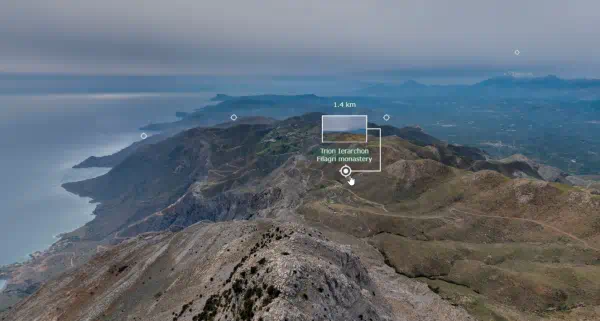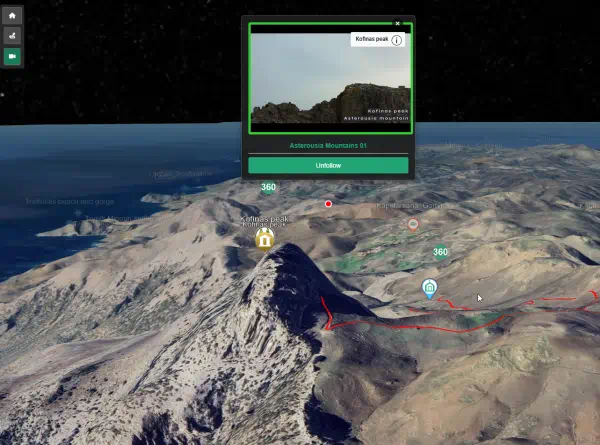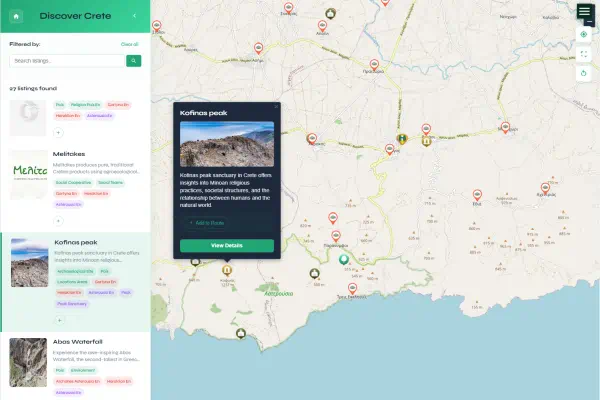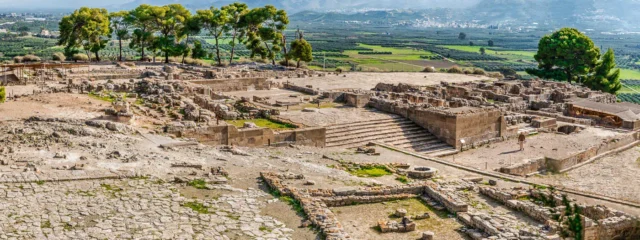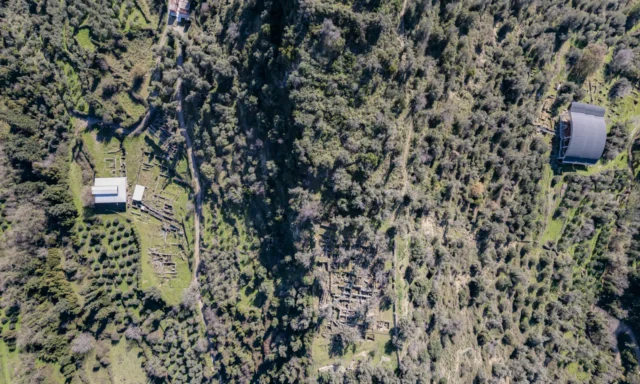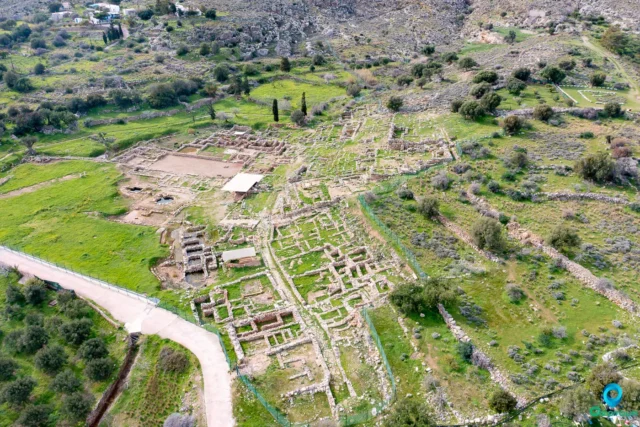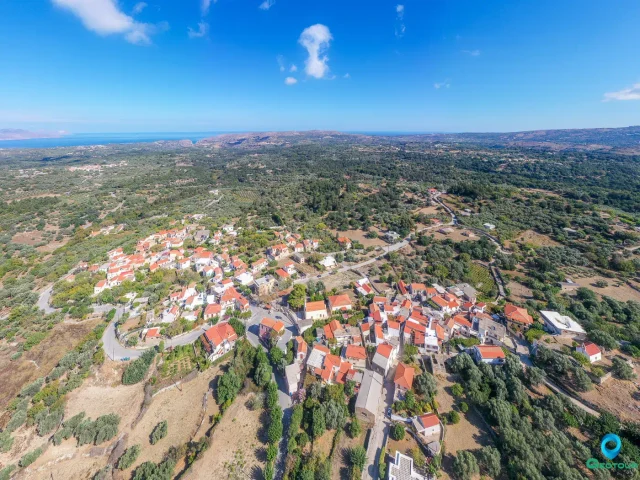Kournas is a mountain village and the administrative seat of the homonymous community in the municipality of Apokoronas, in the Chania regional unit of Crete. It is situated at an altitude of 200 meters, northeast of Mount Dafnomadara, which has a height of 1,680 meters.
History
The village of Kournas served as the headquarters of the revolutionary government during the Cretan Revolution of 1866. In 1897, it was designated as the seat of the General Assembly of the Cretans. A record from 1834 indicates that the village was inhabited by 80 Christian and 5 Muslim families.
Geography and Landmarks
The area surrounding Kournas includes a cave, a well-known walking path, and several rivers that flow through the nearby plain.
Kournas Cave
The cave is located one kilometer from the village on the road to Lake Kournas, at a panoramic spot known as Keratide. It was discovered in 1961. The cave is 35 meters long, 24 meters wide, and has a height ranging from 3 to 4.20 meters. It contains numerous stalactites, stalagmites, and columns.
The Path of Azilakas
This is a circular walking route at the foothills of Mount Dafnomadara, located between Kournas and the village of Kastellos. The path goes through an area with considerable vegetation and has running water for most of the year. Its name is derived from the Holm Oak tree (Quercus ilex), which is called Azilakas in the Cretan dialect.
Rivers
Three rivers provide water to the coastal plain of Kournas, an area known as Kavros. These rivers are the Kavros, the Delfinas, and the Mousellas. The Mousellas, which is possibly the ancient Mesapos river, forms a natural northern border between the regional units of Chania and Rethymno. It originates from the springs of Argyroupoli, the site of ancient Lappa. Evidence such as iron posts and rings found on its banks suggests that the river may have been navigable in antiquity.
Agricultural Products
Until the end of the 20th century, the primary crops cultivated in the village included legumes such as lentils, chickpeas, and beans, as well as wheat, corn, barley, okra, sesame, and peanuts.
Churches
Kournas has several churches of historical and architectural interest.
Church of Agios Georgios
The Church of Agios Georgios (Saint George) is located near the village square. It was constructed in the late 12th century, around 1190, as a three-aisled, wood-roofed basilica. An additional aisle, dedicated to Christ, was added to the south around 1230-1240. The wooden roof was later replaced with pointed arches. In the late 19th century, the interior arcades were replaced with larger arches to create a more unified space, the narthex was demolished, and an ornate, three-lobed bell tower was constructed to the west. The church contains fragments of frescoes from three different periods. The earliest layer, dating to the late 12th century, is an example of the late Komnenian artistic tradition.
Byzantine Chapel of Agia Eirini
The chapel of Agia Eirini (Saint Irene) is situated below the main square. A nearby spring was once the main water source for the village. A written inscription at the entrance indicates that the church was built in 1362 AD by a monk named Alexandros Melachrinos. The frescoes, which include depictions of the Sacrifice of Abraham and the Annunciation, were previously covered with lime, likely to protect them from damage during the Ottoman period.
Church of Agia Varvara
This church is located on the rear side of the village. It was originally dedicated to Zoodochos Pigi (Life-giving Spring). In the early 20th century, it was also dedicated to Agia Varvara (Saint Barbara). According to local tradition, villagers brought an icon of the saint to the village seeking protection from a deadly disease, and in gratitude for their deliverance, they dedicated the church to her as well.
Old and New Churches of the Eisodia
The old church of the Eisodia (Presentation of the Virgin Mary) is a single-aisled basilica built during the Venetian period. The new Church of the Eisodia was built in the late 1960s to accommodate the parish’s needs. It is a basilica with a dome and serves as the main parish church.
Church of Agios Ioannis Prodromos
The church of Agios Ioannis Prodromos (Saint John the Baptist) is south of the village. The annual village festival takes place here.
Lake Kournas
Lake Kournas is the only natural freshwater lake in Crete. The village of Kournas, which was built much later, takes its name from the lake. The name “Kournas” is believed to derive from the Arabic word for “lake” or “bath.” In antiquity, the lake was known as Korisia, and it is thought that a temple dedicated to Korisia Athena was located nearby. The lake is part of the Natura 2000 network and is a protected area for its birdlife. It contains various aquatic species, including eels and a rare two-colored turtle (Malaclemys terrapin), as well as some introduced species. The lake faces environmental pressures from tourism, water extraction for irrigation, and pollution. Local legends exist about the lake’s creation, with one story claiming it is bottomless.
Culture and Traditions
The primary cultural event in the village is the festival, or panigiri, of Agios Ioannis Prodromos (Saint John the Baptist). It is held annually on August 29th at the church dedicated to the saint, which is located in a scenic area south of the village.
Settlement: Key Points
- Location: Municipality of Apokoronas, Chania, Crete. Altitude of 200 meters.
- Historical Significance: Served as the headquarters of the revolutionary government in the Cretan Revolution of 1866 and the seat of the General Assembly of the Cretans in 1897.
- Landmarks: Includes the Kournas Cave, discovered in 1961, and the Church of Agios Georgios, dating to the late 12th century.
- Nearby Feature: The village is named after the nearby Lake Kournas, the only natural freshwater lake on Crete.
- Population Data: The population of the village has been recorded in various censuses over the years.
Year | Population | Notes |
1583 | ||
1881 | ||
1900 | ||
1920 | ||
1928 | ||
1940 | ||
1951 | ||
1961 | ||
1971 | ||
1981 | ||
1991 | ||
2001 | ||
2011 | ||
2021 | 504 |

